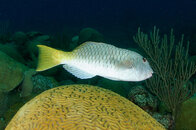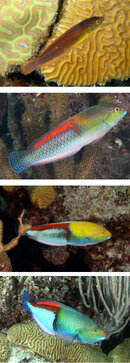Hi, thanks for reading this...
I'm trying to identify two types of fish that I found in Bermuda this summer, not sure if they are just local variants of more common forms...
The first one looks a lot like the initial phase of a Yellowtail Parrotfish (yellow tail, outlined scales), but the body shape is unusual. It wasn't just this individual, there were a lot of them like this. It seems to have this double hump outline that I can't find in any of the usual sources. A puddingwife is more elongated than the typical parrotfish profile, but I don't think that it's one of those, it really looks like a parrotfish apart from the waistline...

The second one looks more like a Yellowhead Wrasse than anything else that I can find (with the vertical color division at the mid-body), but the color patterns are not typical for the Yellowhead - specifically, the back half of the dorsal markings are bright red and the ventral markings are bright blue (as opposed to the more typical dark blue dorsal and dusky ventral on the terminal phase Yellowheads that I have seen). I took what I suspect to be a series of the same species at different phases, but I could be wrong about that too...

Thanks for your help!
Best,
Mike
I'm trying to identify two types of fish that I found in Bermuda this summer, not sure if they are just local variants of more common forms...
The first one looks a lot like the initial phase of a Yellowtail Parrotfish (yellow tail, outlined scales), but the body shape is unusual. It wasn't just this individual, there were a lot of them like this. It seems to have this double hump outline that I can't find in any of the usual sources. A puddingwife is more elongated than the typical parrotfish profile, but I don't think that it's one of those, it really looks like a parrotfish apart from the waistline...

The second one looks more like a Yellowhead Wrasse than anything else that I can find (with the vertical color division at the mid-body), but the color patterns are not typical for the Yellowhead - specifically, the back half of the dorsal markings are bright red and the ventral markings are bright blue (as opposed to the more typical dark blue dorsal and dusky ventral on the terminal phase Yellowheads that I have seen). I took what I suspect to be a series of the same species at different phases, but I could be wrong about that too...

Thanks for your help!
Best,
Mike
Last edited:



